Bermudagrass lawns are a popular choice throughout the southern regions of the United States. Bermuda grass produces a dense, vigorous, and fine-bladed turf ideal for home lawns and pastures. In warmer areas, where soil temperatures do not go below 60 degrees Fahrenheit (15 Centigrade), a Bermuda grass lawn will stay green all year long. In this article, we’ll talk about how to properly aerate bermuda grass, just like professional lawn care companies.
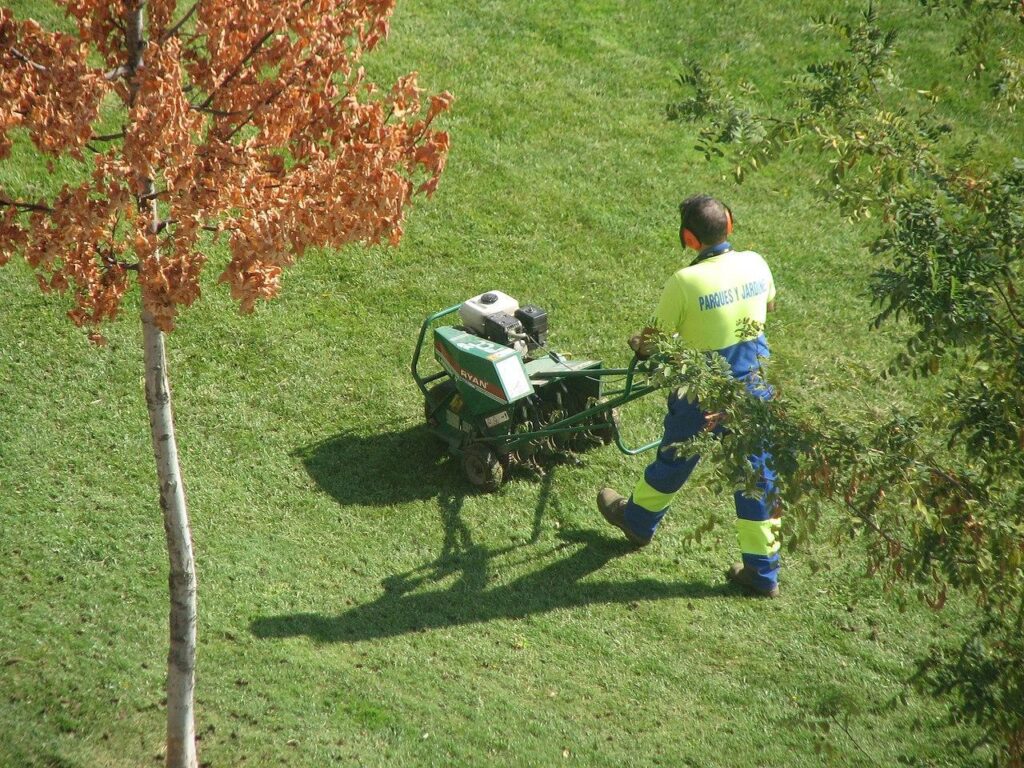
Core aeration during early summer can significantly improve your Bermuda grass health.
In addition to that, Bermuda grass recovers from turf damage rather quickly. As a result, it can withstand heavy foot traffic very well, making it an ideal choice for sports fields and parks. But despite all of its hardiness, a Bermuda grass lawn is not invincible. Poor lawn care practices can quickly turn your entire lawn into a barren of bare brown spots.
For improved turf health, you will have to ensure proper lawn care, and lawn care cannot be completed without aerating the Bermuda grass lawn. Aeration is the process where an aeration machine pokes hundreds and thousands of tiny holes in the soil. These small holes aid air, water and nutrients in penetrating the ground and reaching grass roots.
Aeration is especially needed if the lawn has clay soil in it which makes the ground more prone to soil compaction issues. However, aerating your lawn is not as simple as taking a core aerator machine and digging tiny holes in the whole lawn. There are many dos and don’ts when you aerate your lawn. For instance, warm-season grasses such as St. Augustine, Zoysia, and Bermuda should be aerated in the late spring or early summer.
Whereas, the cool-season grasses such as Fescue and bluegrass should be aerated in early spring or fall. Moreover, you should not aerate your lawn during the spring green as it can damage the grass. So, all in all, aerating Bermuda grass is a good thing; however, doing it in the wrong way and at the wrong time can do more harm than good.
Benefits Of Aerating Bermuda Lawns
Before we get into the details of aerating a Bermuda lawn, let’s quickly go over a few benefits of aeration. This will help you understand why aeration is necessary and beneficial for your lawn and encourage you to do it. The biggest advantage of aeration is that it allows fresh air, water, and nutrients to reach the root zone, thus promoting vigorous growth of the Bermuda grass. Below you can find some other advantages of aerating a Bermuda lawn:
Better Turf Health
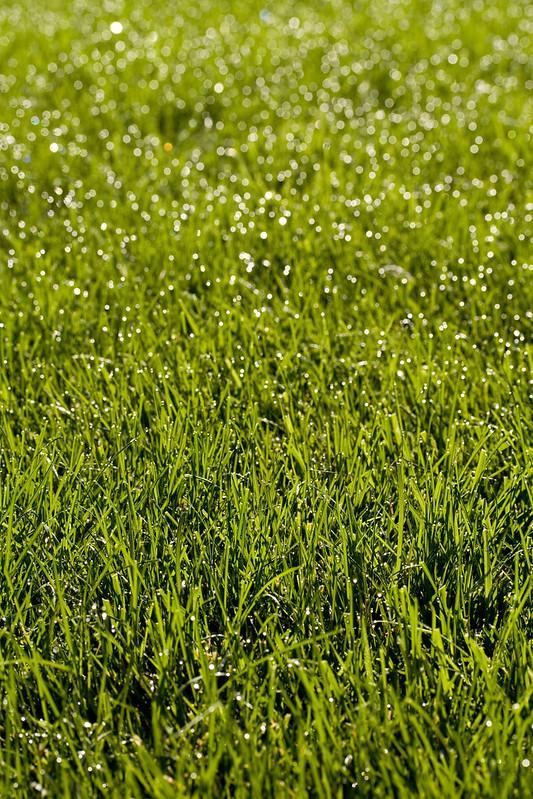
Aeration increases grass resilience and health by promoting deep root development.
One of the best benefits of aerating the lawn is that it improves the overall health of your grass and promotes root growth. Also, aeration aids nutrients in penetrating deeper into the soil, which otherwise might be stuck on the surface of the soil. So, by promoting root growth and assisting the nutrients in reaching deeper into the soil, it increases your grass’s overall growth and resilience. As a result, your grass looks more alive, green and healthier.
Moreover, by promoting deep root development, aeration makes the grass more tolerant to drought conditions. So, if there is dry soil on the top due to heat or drought conditions, roots can still absorb water and nutrients from the deeper layers of the ground.
RELATED: How to Manage St. Augustine Grass Runners: A Comprehensive Guide
Reduced Thatch Buildup
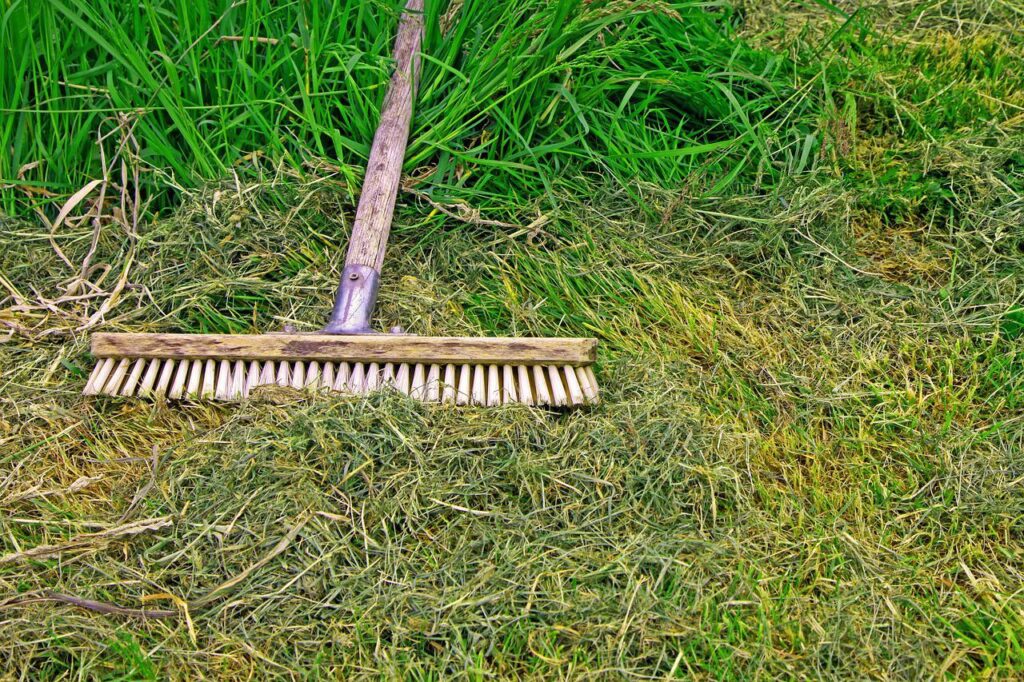
Thatch buildup can significantly reduce nutrient, air, and water uptake by the grass.
If the thatch layer on your lawn soil becomes too thick, it can rob the grass of water, air, and nutrients. It is because it acts as a barrier between the soil and the environment. So, thatch removal is necessary if you want your grass to grow rapidly. This is how aeration helps reduce thatch buildup on your lawn.
When you aerate your lawn, you introduce microorganisms from the deeper soil onto the soil surface. These microorganisms are very good at breaking down organic matter, which primarily thatch is made up of. This aids in the decomposition of thatch and decreases its buildup on an actively growing grass.
Decreased Soil Compaction
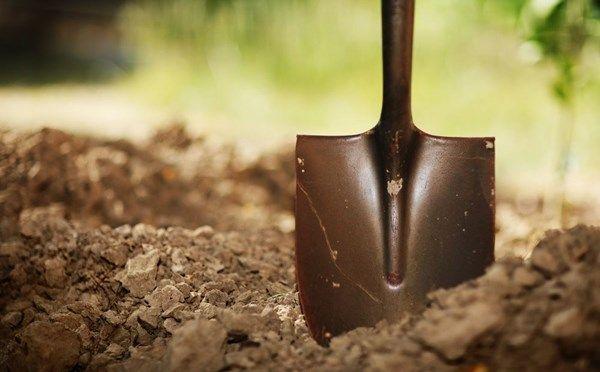
A compacted soil hinders normal root and grass development.
Another great benefit of aerating the Bermuda grass is that it helps relieve the soil compaction of your yard. Soil compaction is especially a problem in lawns with clay soil. It makes soil harder, and as a result, the grass roots cannot grow more than a few inches deep which hinders root and grass development very significantly.
Also, soil compaction results in standing water on the lawn. Standing water can create new problems for the grass and make disease control rather difficult in the yard. When you aerate the lawn, the holes left behind reduce soil density, reducing soil compaction. Also, these tiny holes reduce the amount of water standing on the surface.
pH Modification
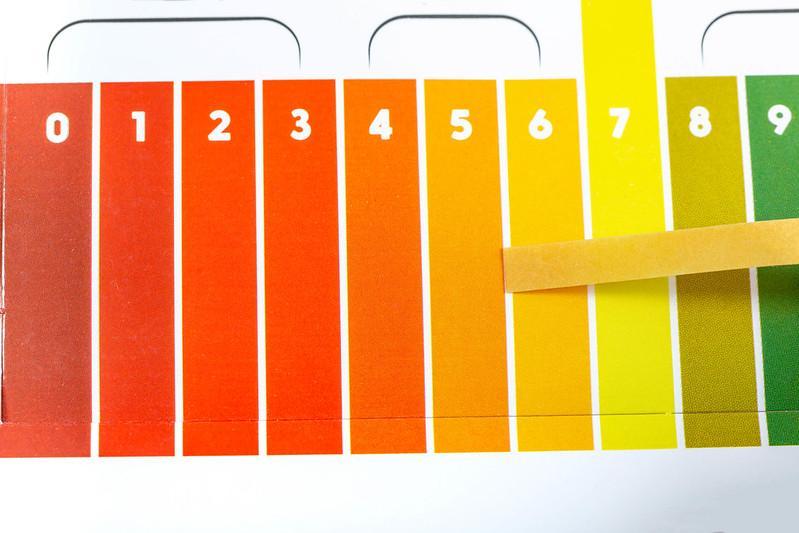
pH is an important moderator of grass growth in your yard.
Every grass has a narrow range of pH in which it grows best. For Bermuda grass, it is 6 to 6.5. If the soil becomes too acidic or alkaline, it will hinder normal grass growth. So, depending on your lawn soil, you might need to modify the pH. For instance, if the soil is too acidic, you can add lime to it, and if the soil is too alkaline, you can use sulfur or an acidic fertilizer.
The process of aeration can help you modify the lawn pH more effectively and rapidly. It will aid the pH modifying elements to reach deeper in the soil and come in contact with the particles better. All of this will facilitate the chemicals to work much better.
RELATED: How To Make Bermuda Grass Thicker, Greener, and Fuller | A Beginners Guide
Improved Overseeding
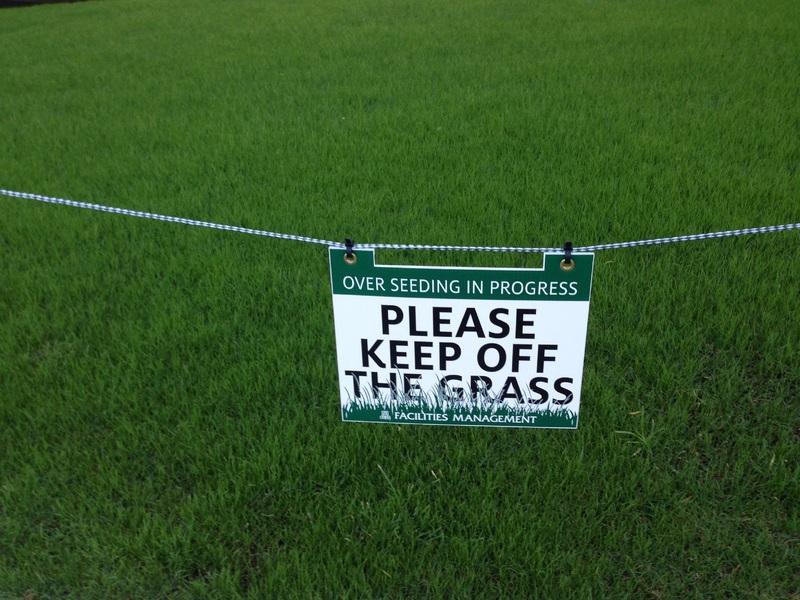
Aeration aids the overseeding process and helps you green up your lawn more quickly.
Overseeding can help your Bermuda lawn green up and become thicker and fuller. Core aeration of the lawn before overseeding can be beneficial if done correctly. It increases the seed-to-soil contact, which increases the seed germination rate. Moreover, due to increased seed-to-soil contact, the new roots can easily take hold of the ground, promoting grass growth.
Reduced Pudding
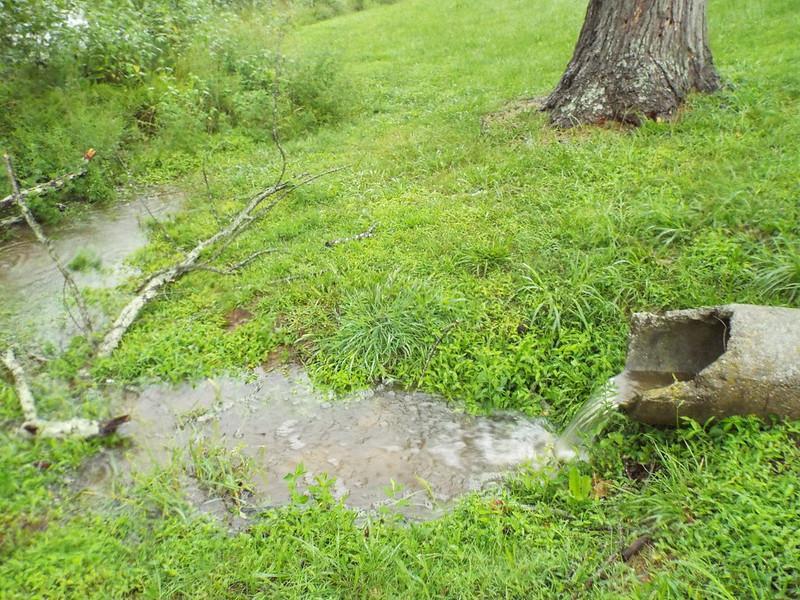
Aeration can help you resolve the standing water issues on your lawn.
If you see water standing on the lawn surface in the form of puddles, you might be dealing with soil compaction issues. Pudding can create numerous problems for your lawn and the grass. It makes your yard look messy and increases the chance of a fungal attack.
Aeration can help you fix this issue. When you aerate your lawn, it will relieve soil compaction and create tiny holes in the surface, which will aid water drain from the surface. Aeration is necessary for lawns or turf areas with high foot traffic where you cannot afford water puddles.
Improved Fertilizer Applications
People often fertilize their Bermuda grass before it goes dormant in the winters. It helps the dormant grass survive the cold. So, if you aerate your lawn before applying fertilizer, it will increase fertilizer absorption very significantly, which will keep the turf healthy.
In addition to that, you can also aerate your lawn before applying a pre-emergent herbicide or a post-emergent herbicide to it. We suggest using a criss-cross pattern for aerating your lawn before fertilizer or herbicide applications.
What Is The Best Time To Aerate Bermuda Grass?
Bermuda grass reaches its peak growing season near mid-summer. That is why you should aerate your lawn during late spring or at the start of the summer. Also, de-compacting the soil during spring will allow better root and grass growth during the summer months.
Spring aeration is the key to establishing a healthy and lush Bermuda grass lawn. Aerating the lawn in summer also prevents weeds from growing on your lawn which helps the grass grow even faster and better as it now does not have to compete.
However, if you have compacted soil on your lawn, you will need to aerate twice or multiple times a year. The first aeration should be performed between April and July, and then if you see if your lawn needs to be aerated a second time, you should aerate it again in the fall.
In order to determine whether or not your Bermuda grass needs aeration, you can consider the following things:
- Lawn traffic: the more the traffic, the larger the need for aeration.
- Thatch buildup: If the layer of thatch becomes more than half an inch thick, it is time to aerate your Bermuda grass.
- Water puddling: if there is standing water on your lawn, aeration might help fix it.
When Should I Aerate My Bermuda Lawn?
You need to aerate Bermuda grass whenever there are any compaction and standing water issues on your lawn. Aerating the lawn will increase water drainage and reduce the density of the soil, which will alleviate any compaction issues. This will increase the rate at which the grass roots develop and help the grass grow better.
In addition to that, you can also aerate the Bermuda grass before applying fertilizer or herbicide. Aerating the lawn will help the chemicals and nutrients reach deeper in the soil, increasing their effectiveness. You can also aerate the Bermuda lawn before overseeding, which will significantly increase the seed germination rate.
How Often Should You Aerate Bermuda Grass?
Usually, aeration once a year is enough. However, if you have a lawn with compacted soil, you might need to aerate your lawn more than once. You can aerate the lawn lightly before fertilizer or herbicide applications. In addition to that, if you decide to overseed the lawn, it would be better to aerate it before the process.
How Do I Core Aerate My Lawn?
Many core aerator machines are available on the market, which could help you do that. A core aerator machine contains hollow tines that remove small plugs of soil and place them on top of the lawn surface. Here, these plugs break, and this is how it works.
However, make sure that you do know what you are doing. If you do it at the wrong time of the year or use the wrong equipment, it can damage your turf. So, if you don’t know much about lawn care, we suggest that you hire professionals to perform aeration on your lawn.
Should You Aerate Bermuda Grass In Fall?
Bermuda enters dormancy during late fall. So, why aerate the lawn when the grass cannot benefit from it? That is why you should not aerate the Bermuda grass during the fall. Fall aeration, however, can be done for cool-season grasses such as Ryegrass and Fescue grass. These grasses show vigorous growth during this time of the year and can benefit from fall aeration.
Should I Aerate Before Overseeding Bermuda Grass?
Overseeding increases seed-to-soil contact as well as the germination rate. So, aerating the Bermuda lawn before overseeding is a very good idea. Also, we suggest that you overseed your lawn within two days of aerating to get the best results.
How Often Should You Aerate a Bermuda Lawn?
The frequency of lawn aeration depends primarily on the soil condition. Here is how you can determine if your lawn needs aeration or not:
- Take a screwdriver and push it into the soil.
- If it easily penetrates two to four inches into the ground, there is no need to aerate.
- However, if you have to apply considerable force on the screwdriver to push it into the ground, it is time to aerate the lawn.
However, make sure that you test many spots in the lawn to see if your lawn needs aeration or not. Also, you should aerate the lawn when it feels spongy because of excessive thatch buildup.
Sources for Further Reading
- Core Aeration of Lawns-Benefits and Procedures. The University of Idaho Extension. Retrieved 12 May 2022, from https://www.extension.uidaho.edu/publishing/html/BUL964-Core-Aeration-of-Lawns.aspx
- Lawn Aeration | University of Maryland Extension. (2022). Retrieved 12 May 2022, from https://extension.umd.edu/resource/lawn-aerationAerating Lawns. Clemson University Cooperative
- Extension Service. (2022). Retrieved 12 May 2022, from https://hgic.clemson.edu/factsheet/aerating-lawns/
Thanks for reading our aerate bermuda grass article. Make sure to check out our other articles:
Pros And Cons of Using Straw To Cover Grass Seed In A Newly Seeded Lawn







